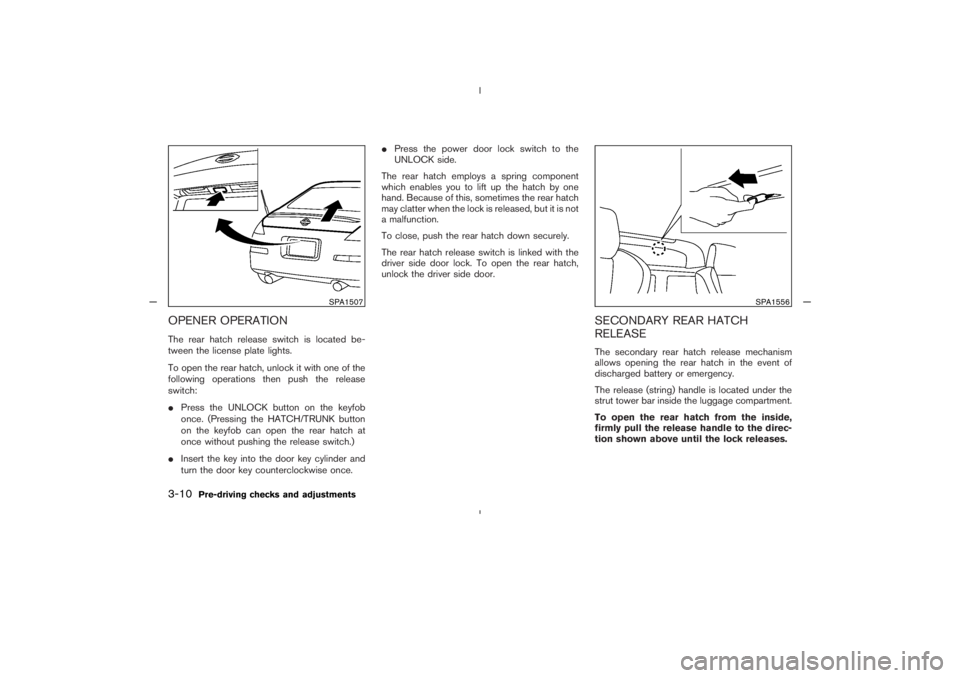Page 13 of 279
1. Fuse/fusible link holder (P.8-22)
2. Battery (P.8-15)
3. Engine oil filler cap (P.8-10)
4. Brake fluid reservoir (P.8-13)
5. Clutch fluid reservoir (M/T models) (P.8-14)
6. Window washer fluid reservoir (P.8-14)
7. Power steering fluid reservoir (P.8-13)
8. Engine coolant reservoir (P.8-8)
9. Radiator filler cap (P.8-9)
10. Engine oil dipstick (P.8-10)
11. Air cleaner (P.8-18)
Do not tamper with the strut tower bar
adjustment
�A. The strut tower bar has
been adjusted to the most suitable posi-
tion at the factory.
SDI1519
ENGINE COMPARTMENT CHECK
LOCATIONS0-8
Illustrated table of contents
�
04.8.23/Z33-D/V5.0
�
Page 93 of 279
REAR PARCEL BOXPush the upper part of the lid to open the rear
parcel box. For models without the Navigation
system, two boxes are available.
WARNING
�The rear parcel box should not be
used while driving so full attention
may be given to vehicle operation.
�Keep rear parcel box lid closed while
driving to help prevent injury in anaccident or a sudden stop.
STOWING GOLF BAGSFollow the instructions here to stow golf bags in
the rear cargo space of your vehicle. Normally
two bags can be stowed in the luggage area
(Coupe models) or one bag in the trunk (Road-
ster models).
However, in some cases you may not be able to
stow the above number of golf bags in your
vehicle, depending on their sizes or types.
Coupe modelsNormally, two standard golf bags can be stowed
across the strut tower bar in the luggage area as
illustrated (A and B). When stowing a golf bag A
in the rear space, insert the top of the golf bag
SIC1977
SIC2196
2-36
Instruments and controls
�
04.8.23/Z33-D/V5.0
�
Page 113 of 279

OPENER OPERATIONThe rear hatch release switch is located be-
tween the license plate lights.
To open the rear hatch, unlock it with one of the
following operations then push the release
switch:
�Press the UNLOCK button on the keyfob
once. (Pressing the HATCH/TRUNK button
on the keyfobcan open the rear hatch at
once without pushing the release switch.)
�Insert the key into the door key cylinder and
turn the door key counterclockwise once.�Press the power door lock switch to the
UNLOCK side.
The rear hatch employs a spring component
which enables you to lift up the hatch by one
hand. Because of this, sometimes the rear hatch
may clatter when the lock is released, but it is not
a malfunction.
To close, push the rear hatch down securely.
The rear hatch release switch is linked with the
driver side door lock. To open the rear hatch,
unlock the driver side door.
SECONDARY REAR HATCH
RELEASEThe secondary rear hatch release mechanism
allows opening the rear hatch in the event of
discharged battery or emergency.
The release (string) handle is located under the
strut tower bar inside the luggage compartment.
To open the rear hatch from the inside,
firmly pull the release handle to the direc-
tion shown above until the lock releases.
SPA1507
SPA1556
3-10
Pre-driving checks and adjustments
�
04.8.23/Z33-D/V5.0
�
Page 212 of 279
1. Fuse/fusible link holder
2. Battery
3. Engine oil filler cap
4. Brake fluid reservoir
5. Clutch fluid reservoir (M/T models)
6. Windshield washer fluid reservoir
7. Power steering fluid reservoir
8. Engine coolant reservoir
9. Radiator filler cap
10. Engine oil dipstick
11. Air cleaner
Do not tamper with the strut tower bar
adjustment
�A. The strut tower bar has
been adjusted to the most suitable posi-
tion at the factory.CAUTION
Tampering with the strut tower bar ad-
justment may cause a noise while driv-
ing or damage to the hood or engine.
SDI1519
ENGINE COMPARTMENT CHECK
LOCATIONS
Maintenance and do-it-yourself
8-7
�
04.8.23/Z33-D/V5.0
�
Page 243 of 279

the front wheels on the vehicle could lead to
transmission damage.
For additional information regarding tires, refer to
“Important Tire Safety Information” (US) or “Tire
Safety Information” (Canada) in the Warranty
Information booklet.Care of wheels�Wash the wheels when washing the vehicle
to maintain their appearance.
�Clean the inner side of the wheels when the
wheel is changed or the underside of the
vehicle is washed.
�Do not use abrasive cleaners when washing
the wheels.
�Inspect wheel rims regularly for dents or
corrosion. Such damage may cause loss of
pressure or poor seal at the tire bead.
�NISSAN recommends that the road wheels
be waxed to protect against road salt in areas
where it is used during winter.Spare tire (T-type spare tire)Observe the following precautions if the T-type
spare tire must be used, otherwise your vehicle
could be damaged or involved in an accident.
CAUTION
�The T-type spare tire should be used
for emergency use only. It should be
replaced by the standard tire at the
first opportunity.
�Drive carefully while the T-type spare
tire is installed.
Avoid sharp turns and abrupt braking
while driving.
�Periodically check the T-type spare
tire inflation pressure, and always
keep it at 60 psi (420 kPa, 4.2 bar).
�Do not drive your vehicle at speeds
faster than 50 MPH (80 km/h).
�Do not use tire chains on a T-type
spare tire. Tire chains will not fit
properly on the T-type spare tire and
may cause damage to the vehicle.
�Tire tread of the T-type spare tire will
wear at a faster rate than the stan-
dard tire. Replace the T-type spare
tire as soon as the tread wearindicators appear.
�Because the T-type spare tire is
smaller than the original tire, ground
clearance is reduced. To avoid dam-
age to the vehicle, do not drive over
obstacles. Also, do not drive the ve-
hicle through an automatic car wash
since it may get caught.
�Do not use the T-type spare tire on
other vehicles.
�Do not use more than one T-type
spare tire at the same time.
�Do not tow a trailer while the T-type
spare tire is installed.
8-38
Maintenance and do-it-yourself
�
04.8.23/Z33-D/V5.0
�